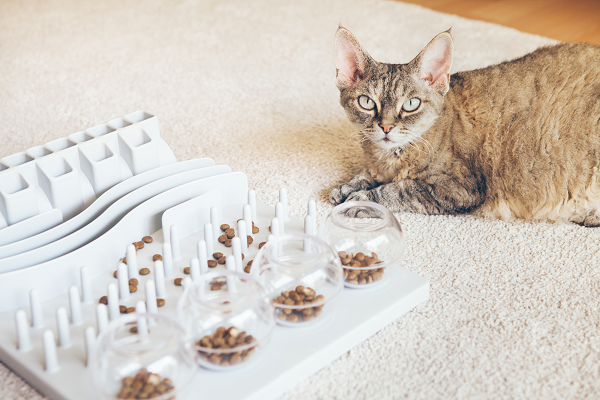
Life is pretty good for our pets. We provide them with all the necessities of life – food, shelter, and water. And lots of love, of course. But sometimes, we all like a challenge. Dogs and cats have hunting instincts, so it is fun for them to have to search for their food sometimes. That’s where puzzle feeders come in.
Puzzle feeders, also known as interactive feeders, are devices that make your pet work for their food. These feeders require brain power and dexterity to solve. Your pet must think, plan, and strategize to get the food out – much as their hunting/foraging ancestors did in the wild.
Interactive feeders come in a variety of designs, from simple to complex. Some target dogs or cats specifically, while others are fun for both. Here are some examples of feeder types you can consider for your pet.
Chew toys with holes or pockets for treats
Dogs often like simple rubber chew toys with holes or pockets that hide kibble. The open end allows the dog to smell the treat, which encourages him to play. Sturdy enough to withstand a lot of chewing, they are perfect for teething pups.
Some manipulative feeders target cats. One shaped like a fishbowl requires kitties to scoop out food with their paws. Others have tunnels or “mouse holes” that encourage the cat to develop a hunting strategy. Cats also enjoy feeders with multiple flexible tubes that hide food.
Some interactive feeders are fun for both cats and dogs. A simple feeding toy that targets both types of pets is a vinyl ball that houses kibble in pockets. As the pet rolls the ball, the kibble falls out. Simple yet effective!
Both cats and dogs also enjoy feeding toys comprised of several compartments that each require a different technique to open. The pet may have to press a button, pull a knob, tug a rope, or slide a drawer to open the slot hiding the treat. Individual compartments can be rotated to maintain the pet’s interest in the game.
Puzzles to manipulate
Another more complex feeder design requires the pet to move parts of a puzzle around to reach a reward. The food is visible, but the dog or cat must figure out how to reach it. One type of puzzle has a plate-shaped base with raised protrusions of different heights. This simulates foraging for food in the grassy outdoors. Food is placed between the protrusions and the pet must use its paws and mouth to push the food around the “blades of grass” until they can grasp it.
These feeders come in many sizes to accommodate large dogs as well as small pups and cats and work with dry or canned food.
Why should my pet use an interactive feeder?
- Alleviate boredom and reduce destructive behavior: Before they were domesticated pets, dogs and cats were working animals. They caught mice, herded livestock, and protected the home. These duties kept them physically and mentally active. While some pets work for a living, most do not. The hardest job most dogs and cats have is serving as good companions while we serve them! With extra time on their “paws,” some pets become bored and lonely. They don’t get to utilize their natural hunting or foraging instincts and may resort to destructive behavior. Interactive feeders may relieve the boredom and help with behavior issues.
- Help pets stay home alone: These feeders may also help pets with separation anxiety. Interactive feeders, when combined with other behavior modification tools, may help alleviate the effects of separation anxiety by distracting and entertaining the pet.
- Reduce over-eating: Inactivity also leads to obesity and health problems. Bored pets, like bored people, tend to nibble all day, consuming excess calories that result in excess weight gain and associated health problems. Interactive feeders provide small portions of food, combat boredom, and keep pets mentally stimulated. Some may even require physical work that burns calories.
- Slow down eating: Specialty feeding devices can also help pets that eat too aggressively. Dogs and cats that gulp their food or binge eat can develop digestive disorders such as regurgitation, bloat, or vomiting. Interactive feeders force them to eat slower and may decrease these problems.
Note – if your pet is used to eating from a bowl, it may take some time for them to adjust to using a puzzle feeder. Before giving up, first try to reduce the difficulty of the task and improve the value of the reward. Try giving the toy when your pet is a little hungry – just before feeding a scheduled meal. You could try putting some food in the toy and some in the bowl and working up from there.
Besides being fun, interactive feeders can help keep pets happier and healthier. While pet owners will still provide the necessities of life for their furry family members, it’s good to let them work some things out on their own. A little challenge is a good thing!
